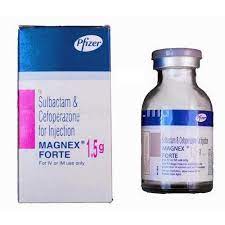magnex Forte
ABOUT MAGNEX FORTE
Magnex Forte is a brand name for the generic medicine combination of Cefoperazone (1000mg) and Sulbactam (500mg). This combination is primarily used to treat a variety of bacterial infections, including those affecting the respiratory tract, urinary tract, skin, and soft tissues. Cefoperazone is a third-generation cephalosporin antibiotic, while Sulbactam is a beta-lactamase inhibitor. Together, they work synergistically to combat bacteria that are resistant to other antibiotics.
Magnex Forte is available in the form of an injectable solution, which allows for rapid absorption and action in the body. This medicine is produced by Pfizer Ltd, a reputable pharmaceutical company known for its commitment to quality and innovation in healthcare. Pfizer Ltd meets WHO Good Manufacturing Practice (GMP) certification criteria according to CDSCO, ensuring that Magnex Forte is manufactured to the highest standards of safety and efficacy.
Alternatives to Magnex Forte include other brands with the same composition, such as Cefosulbactam and Sulperazone. These alternatives provide similar therapeutic effects and can be considered in cases where Magnex Forte is not available or suitable for the patient.
INTRODUCTION OF MAGNEX FORTE
Magnex Forte is a potent antibiotic medication designed to tackle severe bacterial infections that are unresponsive to standard treatments. It is particularly effective against infections caused by Gram-negative and Gram-positive bacteria, making it a versatile option for healthcare providers. The combination of Cefoperazone and Sulbactam in Magnex Forte enhances its ability to penetrate bacterial cell walls and inhibit the enzymes that bacteria use to resist antibiotics. This dual action not only kills the bacteria but also prevents them from developing resistance, ensuring a more comprehensive treatment approach.
In clinical settings, Magnex Forte is often used in hospitals to treat serious infections such as pneumonia, peritonitis, and sepsis. Its broad-spectrum activity makes it a valuable tool in the fight against multi-drug resistant bacterial strains. The inclusion of Sulbactam in the formulation is particularly beneficial as it extends the spectrum of Cefoperazone by inhibiting beta-lactamase enzymes, which are commonly produced by resistant bacteria. This makes Magnex Forte an essential option in the antibiotic arsenal, especially in environments where antibiotic resistance is a growing concern.
Patients receiving Magnex Forte can expect a reduction in symptoms such as fever, pain, and inflammation as the medication works to eliminate the underlying bacterial infection. It is typically administered by healthcare professionals in a clinical setting, ensuring that the dosage and duration of treatment are tailored to the specific needs of the patient. This personalized approach helps to maximize the effectiveness of the treatment while minimizing potential side effects. Overall, Magnex Forte represents a critical advancement in the treatment of complex bacterial infections, offering hope to patients and healthcare providers alike in the ongoing battle against antibiotic resistance.
CONDITIONS TREATED BY MAGNEX FORTE
Magnex Forte is used to manage a wide range of bacterial infections, including respiratory tract infections, urinary tract infections, skin and soft tissue infections, intra-abdominal infections, and septicemia. It is particularly effective in treating infections caused by resistant strains of bacteria, making it a crucial option in severe or complicated cases.
MOLECULE NAME
Cefoperazone (1000mg) + Sulbactam (500mg)
HOW IT WORKS MAGNEX FORTE
Magnex Forte works by combining the antibacterial properties of Cefoperazone with the beta-lactamase inhibiting action of Sulbactam. Cefoperazone disrupts the synthesis of the bacterial cell wall, leading to cell lysis and death. Sulbactam enhances this effect by inhibiting the beta-lactamase enzymes that some bacteria produce to resist antibiotics. This combination ensures a broader spectrum of activity and reduces the likelihood of resistance development.
COMMON SIDE EFFECTS OF MAGNEX FORTE
Common side effects of Magnex Forte may include diarrhea, nausea, vomiting, rash, and injection site reactions. These side effects are generally mild and resolve on their own. However, if they persist or worsen, it is important to consult a healthcare professional.
HOW TO TAKE MAGNEX FORTE
Magnex Forte is administered as an injection by a healthcare professional. The dosage and duration of treatment depend on the type and severity of the infection, as well as the patient's overall health condition. It is important to follow the healthcare provider's instructions carefully to ensure the best possible outcome.
PRECAUTIONS OF MAGNEX FORTE
Before using Magnex Forte, inform your healthcare provider about any allergies, medical conditions, or other medications you are taking. This medication should be used with caution in patients with liver or kidney impairment. Pregnant or breastfeeding women should only use Magnex Forte if clearly needed and prescribed by a healthcare professional. Regular monitoring of blood counts and liver function tests may be required during treatment.
FOOD & DRUG INTERACTIONS OF MAGNEX FORTE
Magnex Forte may interact with other medications, such as anticoagulants and aminoglycosides, potentially altering their effects. It is important to inform your healthcare provider of all medications and supplements you are taking. Avoid alcohol consumption during treatment, as it may increase the risk of side effects.
ALTERNATIVE BRANDS OF MAGNEX FORTE
Alternative brands with the same composition as Magnex Forte include Cefosulbactam and Sulperazone. These alternatives provide similar therapeutic effects and can be considered if Magnex Forte is not available or suitable for the patient.
FACT MEDICINE OF MAGNEX FORTE
Magnex Forte is a powerful antibiotic used to treat severe bacterial infections. It combines Cefoperazone and Sulbactam to provide broad-spectrum activity against resistant bacteria. Manufactured by Pfizer Ltd, it meets high-quality standards and is administered in a clinical setting. Common side effects include gastrointestinal disturbances and injection site reactions. It is important to follow healthcare provider instructions and report any persistent side effects.

Similar Medicines
More medicines by Pfizer Ltd
Available in 4 variations

vial of 1 injection

1 vial of 1 injection

vial of 1 Injection

1 vial of 1 injection
Disclaimer : This information is not a substitute for medical advice. Consult your healthcare provider before making any changes to your treatment . Do not ignore or delay professional medical advice based on anything you have seen or read on Medwiki.
magnex Forte
Prescription Required
Manufacturer :
Pfizer LtdComposition :
cefoperazone + sulbactam












.svg)
